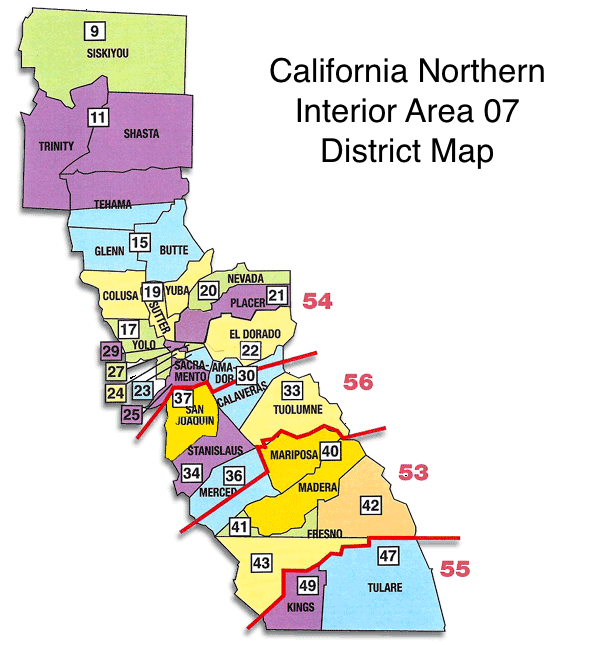WHERE IS CALIFORNIA NORTHERN INTERIOR AREA (CNIA) 07?
California Northern Interior Area (CNIA) is one of six A.A. General Service Areas in California and extends from the Oregon border in the inland valleys south to Kings and Tulare Counties. CNIA contains 29 Districts including five Spanish Language Districts.
WHAT DOES CNIA DO?
Simply put, CNIA is your link to AA as a whole. Each District’s Committee Member (DCM) shares information from their local meetings, some of which is forwarded to the AA General Service Office (GSO) in New York. Our direct voice to GSO is the Area Delegate. The Delegate also reports to the Area what has
come from GSO – information about Alcoholics Anonymous such as the Annual Conference Report or what’s happening with Literature, the Grapevine and LaViña. We will also learn when a new edition of the Big Book is being considered and what is happening through AA World Services, etc. Four meetings per year are Assemblies held at various locations within our Area and generally require some travel. Every two years new officers are elected at the Area Election Assembly. The officers are Delegate, Alternate Delegate, Chair, Alt. Chair, Treasurer, Recording Secretary and Registrar. DCMs and GSRs are also elected
in your Districts to serve 2-year terms. Each two-year term is called a Panel, whether it is at Area or District level. For instance, the term for 2008-2009 was Panel 2010-2011 is Panel 60. This number refers to the number of years since the first General Service Conference was held.
PURPOSE OF THE AREA
Not all areas operate in the same way, but generally speaking, an area’s purpose is threefold:
1. To elect a delegate who will represent the area’s conscience at the annual General Service Conference,
where decisions are made that affect A.A. throughout the U.S. & Canada.
2. To form a local decision-making structure so groups can collectively decide on matters that affect
their area.
3. To carry out Twelfth Step work that may not be practical for groups, districts or intergroups to take
on by themselves. Examples include, but are not limited to:
• Accessibility
• Area bulletin or newsletter
• Cooperation with the Professional Community (CPC)
• Corrections
• Informational website
• Language translation services
• Literature, including Grapevine and La Viña
• Public Information (PI)
• Treatment Facilities
COMPOSITION OF AREA ASSEMBLY:
The following trusted servants are typically voting members of an area assembly:
• GSRs — representing the conscience of the groups in the area
• DCMs — representing the conscience of the districts in the area
• Area officers — elected by the GSRs and DCMs to serve the area
• Area committee chairs — typically appointed by the area chair or elected by the assembly
• Area delegate — elected to represent the conscience of the area at the annual General Service Conference meeting
In some areas, past delegates and intergroup/central office liaisons are also members of the Assembly, with a voice and (sometimes) a vote. Generally speaking, area assembly meetings are open to all A.A. members, but the group’s vote is carried by the GSR. GSRs are already voting on their behalf.

WHO SHOULD ATTEND MONTHLY AREA COMMITTEE MEETINGS (ACMs)?
Any and all AA members are welcome and encouraged to attend these meetings. All District Committee Members (DCMs) and elected Area Officers are expected to attend the Area Committee Meetings (ACM) and Area Assemblies. The AA groups are encouraged to financially support their GSRs to attend the Assemblies as part of the GSR’s job. DCMs are financially supported by their Districts. Appointed position chairs who may choose to attend the ACM are the Accents publisher, Archives, Grapevine and Literature Chairs who are appointed by the Area Chair. Other committee chairs or liaisons are E-Services, Finance, Translation, Bridging the Gap (BTG), Public Information and Cooperation with the Professional Community (PI/CPC). Hospitals and Institutions (H&I), the YPAAs, and Central Office liaisons are also likely to attend the ACMs and Assemblies.
CNIA AREA COMMITTEE SERVICE EXPECTATIONS
Described herein are the expectations common to ALL of the Offices (in addition to the corresponding sections of the A.A. Service Manual).
- To attend all Area Committee Meetings, Assemblies, Officers’ Meetings, and special meetings as may arise concerning Area business as a participating and voting member.
- To continue reading and developing familiarity with A.A.’s Twelve Traditions and history as found in the A.A. Service Manual, the Twelve Concepts for World Service, A.A. Comes of Age, and other literature concerning A.A. history.
- To maintain a willingness and availability to serve on panels put on by Districts and other A.A. entities, as requested.
- To attend District Meetings as a CNIA Officer, when requested.
- To cooperate with the Area Delegate and other Area Officers in discussing the state and needs of the Area.
- To regularly report to the Area any activity or information related to their position concerning Area business.
- To maintain expense records with regard to mileage, lodging, telephone, postage, and other necessary expenses for reporting to the Area Treasurer within 30 days.
- To be available to attend all Regional and Area service functions.
- Be available to participate in a “pass–it–on” for the incoming Officer.
- To provide the leadership necessary to foster a sound service structure in the Area.
